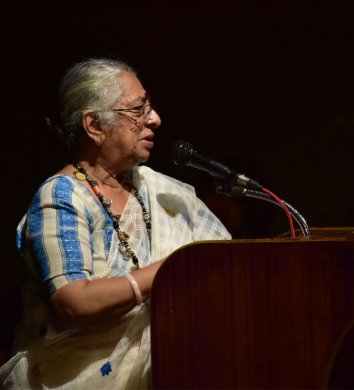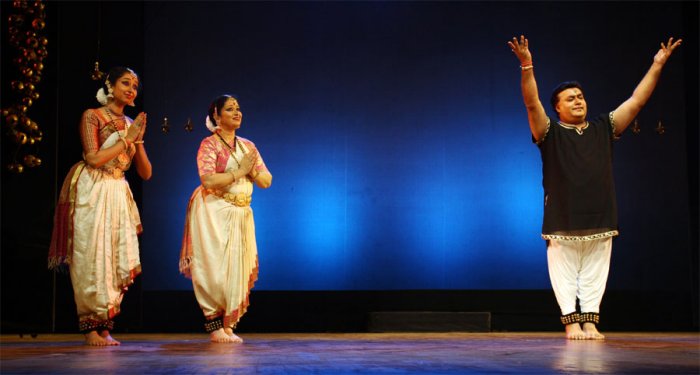
|   |

|   |
The 6th edition of Mulam - Rathna Supriya Sridharan e-mail: rs@nnpnrithyam.com Photos: VB Suresh Babu & Mansur Khan August 13, 2019 Mulam-The Roots conceptualized by Guru Vyjayanthi Kashi saw the tradition of Guru Sishya parampara flow through the family in the 6th edition by Shambavi School of Dance which was held on July 19, 2019 at ADA Rangamandira, Bengaluru. The session opened with the learning methodologies shared by the artistes of the evening. The dynamic theatre personality Dr. B Jayashree, the chief guest of the evening, gave an endearing insight into her beautiful journey through the decades from the days of the oil lamps to the days of the halogen. She unfolded her learning process as keen observation from the side wings from the tender age of 4 by keeping all her Indriyas open to conquer. Unlike the Guru Sishya parampara that classical dance and music traditions follow, Janapada, the folklore and Ranga Bhoomi, the colourful stage is their Guru and Mother, their Thaye Beru as it is called. The actors, she says, were self taught and they emoted through dialogue, sangeetha, nrithya, sahithya which was drawn from and through their experiences and observations in day-to-day life and were greatly influenced by farmers. The difficult times that we face in life always has an upsurge of emotional outpour; this has been the source of expression of theatre artistes through song or a phrase that arises, thus is born a new theme of presentation. They spoke aloud, she said, and articulated each word to be heard by the spectator far beyond. No mikes, no electric lights, but they whole heartedly entertained audience through the night lit by lamps, giving their best, especially, to the ones who have paid to watch them, as they were considered as their Annadhatha. Such was the commitment, passion and sandhana. These values that Jayashree looks up to were inculcated in her by her grandfather, the legendary Gubbi Veeranna, mother Jeevamalathamma and other family members of great repute in the field. Who would carry the mantle forward? Is it the child, sishya, relative or a fan is a question of concern. Years of learning, performing and enriching one's knowledge and thus imparting this to the future generations, the senior gurus have strived and built layers and layers of their experiences to create their school of learning which should be gracefully carried forward by able hands, be it their child, sishya, relative or fan. To highlight this, the following combination of artistes were the evening performers - Guru B. Bhanumathi along with her sister-in-law Guru Sheela Chandrasekar; Guru Vyjayanthi Kashi and daughter Prateeksha Kashi; Gurus Kiran Subramanyam and Sandhya Kiran with daughter Rasika Kiran.  Dr. B Jayashree  Sheela Chandrasekar and B. Bhanumathi In the seminar as the speakers expressed themselves it was evident that whatever their family bound relationship is, the one that holds them is the Guru Sishya relationship. Bhanumati said that Sheela is her sishya in class and sister-in-law at home, who is more close to her as she understands her likes and dislikes much better. They both are of the opinion that the generation gap is bridged because of their good understanding and acceptance. The exposure that Sheela has to the present scenario helps Bhanumati get feedback and helps her to keep on par with the present situation. She is open to new ideas of choreography by Sheela, which is asymmetrical formations, whereas she adheres only to symmetry. Sandhya Kiran says she sits quietly in class admiring the way her husband Kiran Subramanyam weaves out a choreography amazing her. Kiran in turn looks up to wife Sandhya for advice and corrections, a beautiful, respectful, friendly relationship that they all carry and the same is said about Rasika Kiran by her parents that she has never forced her opinions and is humble and patient as a student. Kiran defined a Guru as one who kindles in a student love, self confidence, courage and shows the way to understand oneself. He appealed to the younger generation of sishyas to give up their impulsiveness and see through the undeterred love and forgiving nature of their Guru who embraces them despite their innumerable mistakes. Hence, leaving a Guru because some item or two was not taught is unreasonable.  Vyjayanthi Kashi and Prateeksha Kashi Vyjayanthi Kashi summed up the seminar and highlighted the fact that Guru Sishya parampara is oral tradition which has to be learnt by keen observation and intense memory bank. She said it is an understanding between the Guru and sishya which creates a rapport between the two. She also emphasized that the sishya should imbibe the psychological aspects and not want to be a carbon copy. Mulam or the roots have to be absorbed which is the Mother of Arts in this case. She states an example of an Israeli student who was confused and fearful always as she comes from a place which has seen a lot of violence. This made her understand the influence of the Motherland too, which creates a personality. She says a Guru is one who builds the personality by grooming the student through guidance and corrections and today she feels orphaned in the absence of her gurus and mother and says a Guru is a mother, our land and guide too. This was followed by performance by the above artistes. Guru Bhanumathi and Sheela indulged in friendly gossip; their conversation brought forth the carefree character of the girl next door. This presentation carried no barriers of guru-sishya but portrayed friendliness in the padam Choodare, ragam Sahana, mishra chapu tala. Varugalamo Ayya where the devotee Nandanar pleads with the Lord to let him be by his side surpassing the guards and the Nandi is a composition of Gopalakrishna Bharathi. It was a delight to watch Bhanumathi through this intense bhakti piece and commendable was her Nataraja pose. Geetopadesam was well executed by Sheela to the music score by Praveen D Rao. The Kashis chose to play their respective roles through Bhoomadevi, the Mother, and Sita, the daughter. Starting from the introduction of the characters, the emotional bonding was well established. The varied emotions of the mother weaved through the episodes of the daughter's life. Her joy when her daughter is ready to be married, showers her blessings, her pain when child is abducted and protects her, her agony when her daughter is abandoned, advices her to go back, but, mother she is and yields to her daughter's request and embraces her to eternity. This unique piece with narratives was well presented by Vyjayanthi Kashi and charming Prateeksha; both complimented each other through their grace and expressiveness. The lighting and good usage of the stage and synchronization of both the artistes enhanced the presentation.  The Kirans Devaranamas were what the Kirans chose. Krishna nee begane baro portrayed Krishna as a child playing pranks with his father performed by Kiran and as a lover teasing the gopika performed by Sandhya Kiran. Both artistes shared either side of the stage which was unique in its own way. Rasika Kiran had a special blessing as she shared the stage with her parents for the first time. It was indeed a treat to watch this budding artiste's childish play as Lord Ganesha with her parents in the devaranama Prabho Ganapathe. This grand finale was seeking blessings for future editions of Mulam as envisaged by Vyjayanthi Kashi. Rathna Supriya Sridharan is a senior disciple of Late Guru Padmini Ramachandran. |